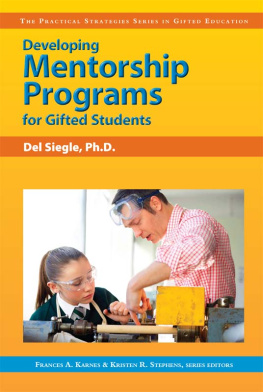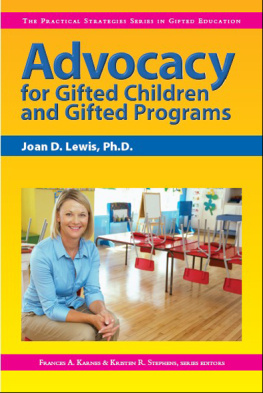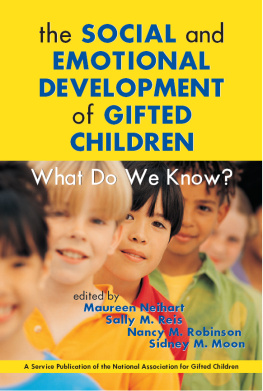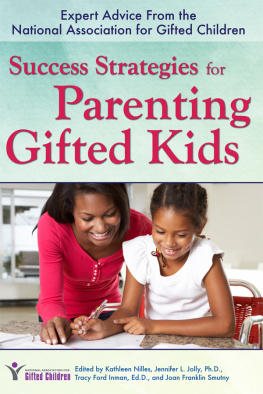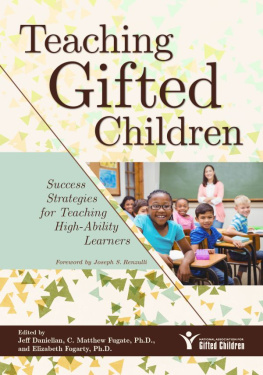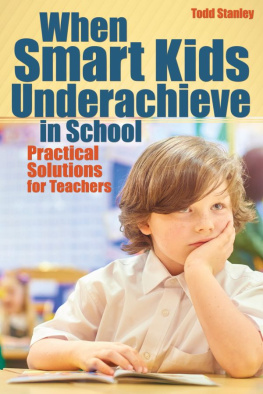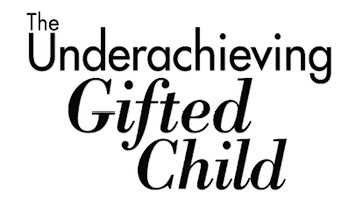
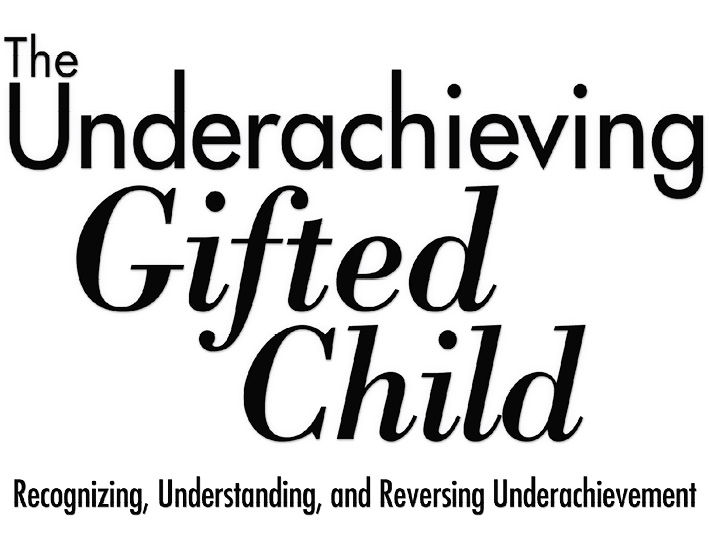
Del Siegle, Ph.D.
A CEC-TAG Educational Resource
Cheryll M. Adams, Ph.D., Tracy L. Cross, Ph.D., Susan K. Johnsen, Ph.D., and Diane Montgomery, Ph.D., Series Editors

PRUFROCK PRESS INC.
WACO, TEXAS
Copyright 2013, Prufrock Press Inc.
Edited by Jennifer Robins
Cover and layout design by Raquel Trevino
ISBN-13: 978-1-61821-041-8
No part of this book may be reproduced, translated, stored in a retrieval system, or transmitted, in any form or by any means, electronic, mechanical, photocopying, microfilming, recording, or otherwise, without written permission from the publisher.
At the time of this books publication, all facts and figures cited are the most current available. All telephone numbers, addresses, and websites URLs are accurate and active. All publications, organizations, websites, and other resources exist as described in the book, and all have been verified. The author and Prufrock Press Inc. make no warranty or guarantee concerning the information and materials given out by organizations or content found at websites, and we are not responsible for any changes that occur after this books publication. If you find an error, please contact Prufrock Press Inc.
 | Prufrock Press Inc.
P.O. Box 8813
Waco, TX 76714-8813
Phone: (800) 998-2208
Fax: (800) 240-0333
http://www.prufrock.com |
Acknowledgments
Much of my understanding of underachievement has been influenced by my research and my life partner, D. Betsy McCoach. This book reflects 13 years of discussions, research, writing, and reading about the topic, and I am indebted to her for her insight and inspiration.
Some of this work was supported by The National Research Center on the Gifted and Talented under the direction of Joseph Renzulli and E. Jean Gubbins. This work was funded through the Educational Research and Development Centers Program, PR/Award Number R206R000001, as administered by the Institute of Education Sciences, U.S. Department of Education. The findings and opinions expressed herein do not reflect the position or policies of the Institute of Education Sciences or the U.S. Department of Education. I wish to acknowledge the contributions of other members of our research team: Sally M. Reis, Meredith Greene Burton, Fredric Schreiber, and Rebecca Mann.
). It generously allowed me to use material from one of its excellent publications.
I also wish to thank Kelly Shea for her editing and feedback on the initial document, Susan Johnsen at CEC-TAG for suggesting I write this book, and Jennifer Robins at Prufrock Press for her editing skills and incredible patience.
This book is dedicated to the Special Talents Education Program (STEP) students I taught in Glendive, MT. Working with them was a special time in my life, and much of what I know in gifted education I learned from them.
chapter
Introduction
The greatest achievement of the human spirit is to live up to ones opportunities and make the most of ones resources.
Luc de Clapiers
Underachievement is among the most frustrating and bewildering education issues parents and educators face. It is not a crisis of a certain group of people; it is a very real factor in the lives of students from both low and high socioeconomic groups and from rural as well as urban areas. Although it is more common among males, it can also be an issue for females. Underachievement often surfaces around middle school and can continue into high school and beyond (Peterson & Colangelo, 1996). A majority of male underachievers are already underachieving during seventh grade, compared to a majority of female underachievers, who begin to underachieve during eighth and ninth grade (Peterson & Colangelo, 1996). Some researchers have suggested that as high as 50% of gifted students underachieve at some point. However, the extent of underachievement among gifted students is difficult to measure for two reasons. First, there is no universally accepted definition of giftedness. Second, some controversy surrounds what criteria should be used to define underachievement.
On the surface, educators and parents may view academic underachievement as a motivation issue. However, underperforming is much more complex than simply not being motivated. Additionally, several factors contribute to individuals being motivated. Students fail to engage and fail to achieve for a variety of reasons. The purpose of this book is to review the reasons why students are not achieving to their full potential and to discuss strategies that they and others in their environment can consider to help reverse their underachievement.
In the early 1990s, Csikszentmihalyi (1993) coined the term flow to describe peak experiences people have. During these experiences, individuals are completely absorbed in what they are doing and often lose track of time. Generally speaking, flow occurs when activities offer a high degree of challenge in areas where individuals perceive themselves as possessing a high degree of skill. Maximum performance occurs during these flow experiences. Flow occurs when individuals have clear goals, decisiveness, the merging of action and awareness, complete (yet effortless) concentration, a sense of control, loss of self-consciousness, an altered sense of time, immediate feedback, and a focus totally on the activity without regard to self (Csikszentmihalyi, 1993). One goal of parents and educators can be to help young people become more engaged so they can have flow experiences. My own work (Siegle & McCoach, 2005b) has shown that students who believe they have the necessary skills to perform a task, who find the task meaningful, and who feel supported in their efforts tend to embrace learning and achieve. Unfortunately, these conditions are often not present for many gifted and talented students in school.
Gentry (Gentry, Rizza, & Gable, 2001) has suggested that five interrelated concepts should underlie educational programs for gifted and talented students: challenge, choice, interest, enjoyment, and personal meaning. Many gifted students are not being academically challenged because they have long ago mastered the content they are being asked to complete (Reis et al., 1993). This is particularly true during the early elementary years. It can be problematic for students because they fail to develop the self-discipline, work habits, and effective study skills that they need once the curriculum does become challenging. A second danger is that they do not come to expect school to be an exciting place for them to grow or to learn new things.
Gifted and talented programs have traditionally focused on identifying students interests and strengths and providing them with opportunities to explore their passions (Renzulli, 2012). Unfortunately, when economic times are difficult, gifted and talented programs are often the first to be cut (Purcell, 1994). Gifted and talented students also spend the majority of their school experience in the regular classroom where differentiation and choice options are limited (Archambault et al., 1993). Although teachers may want to provide appropriate educational opportunities for the gifted and talented students in their classroom, few teachers have received the necessary training to understand the needs of gifted and talented students and how best to serve them (Archambault et al., 1993).
Next page

